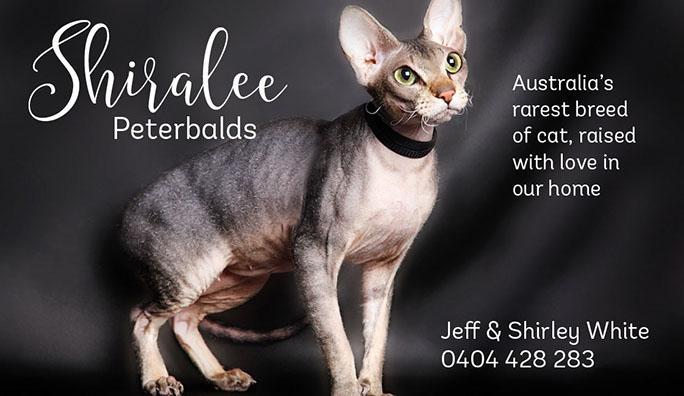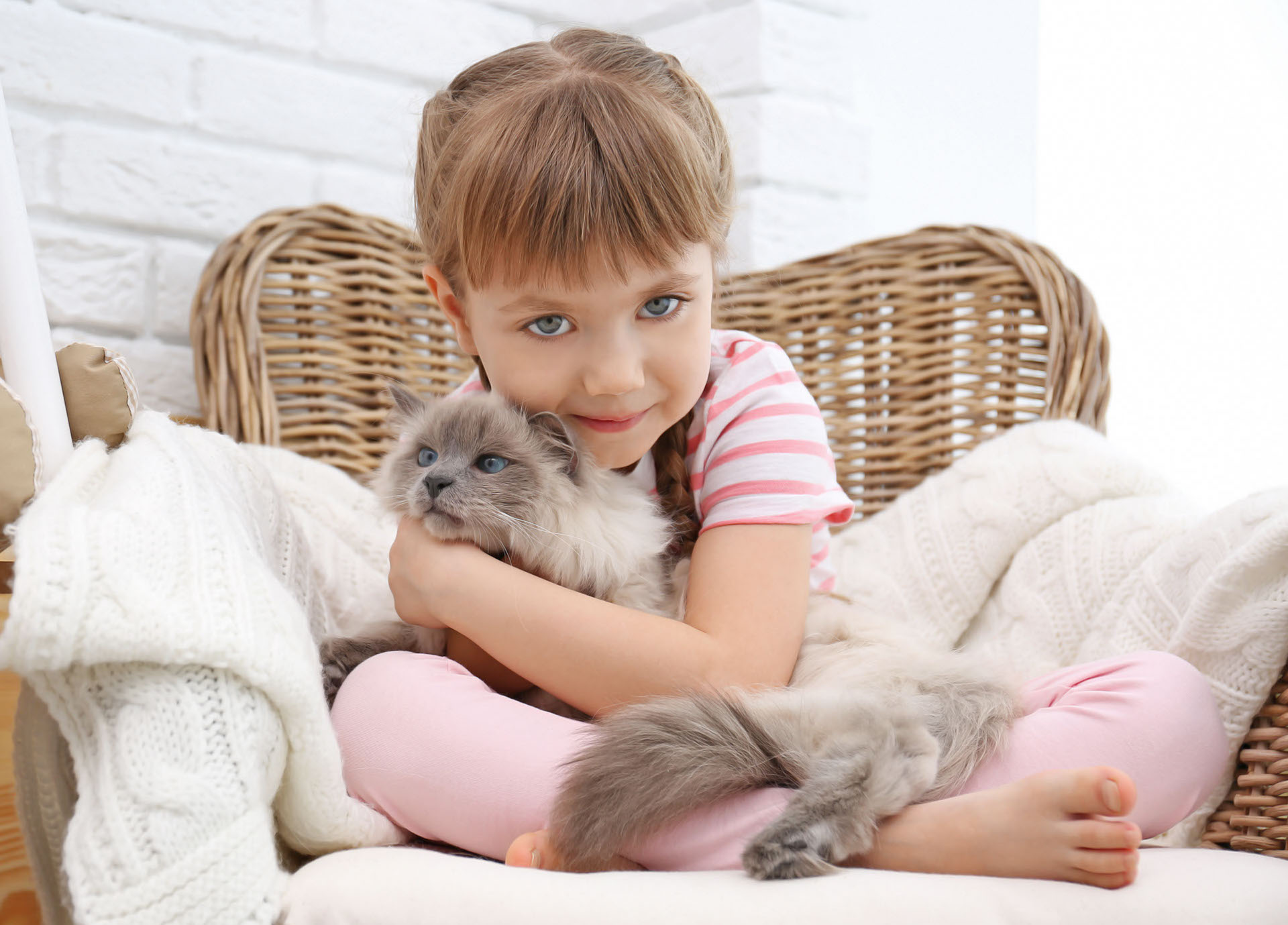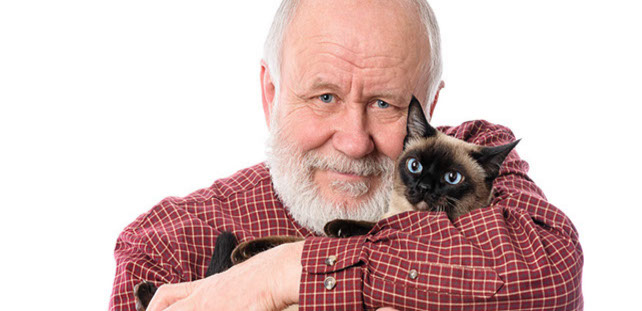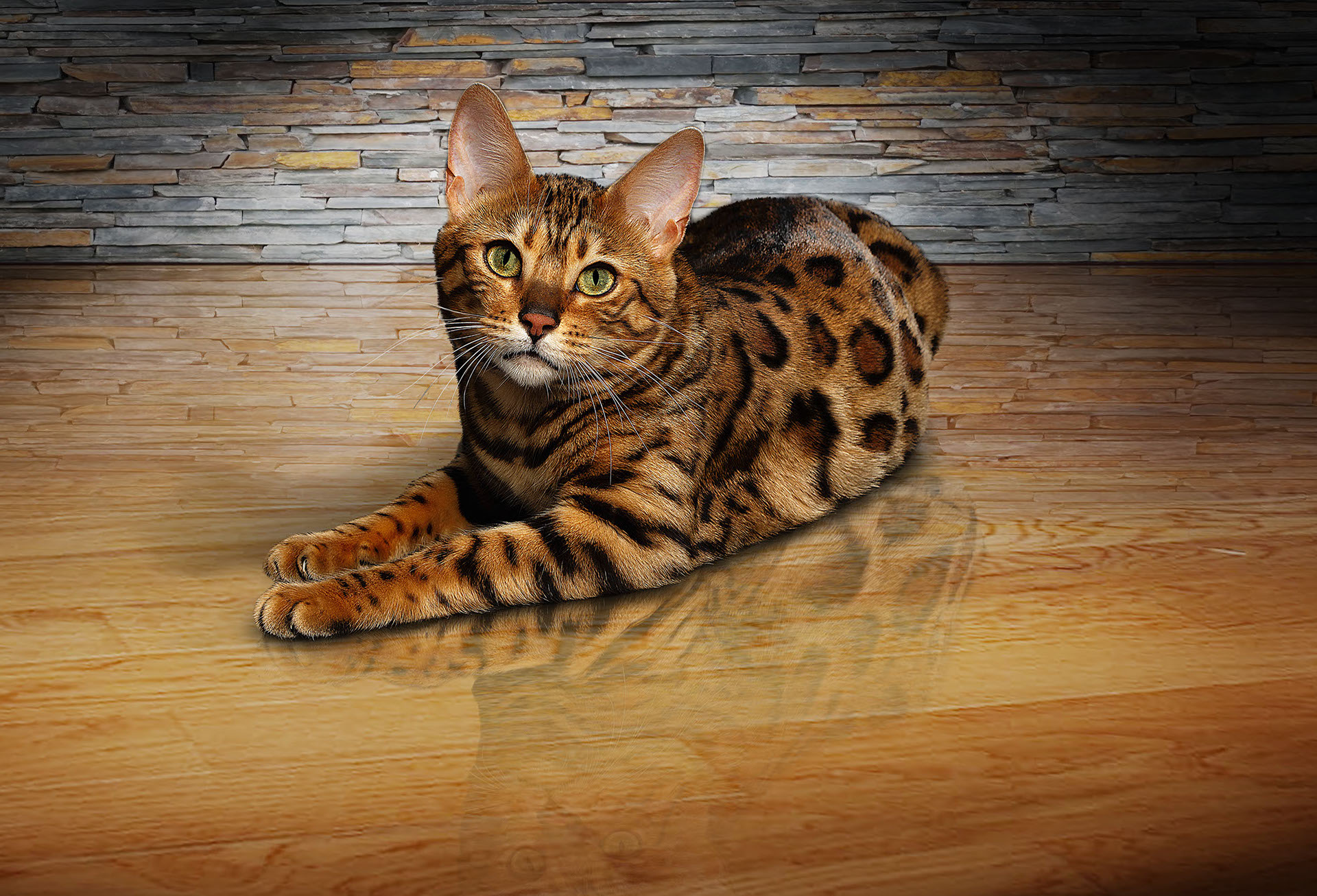
About Us
Breeders
Partners
Membership
Quick
Guide
Judges
Forms
Shows
Kids
Contact Us
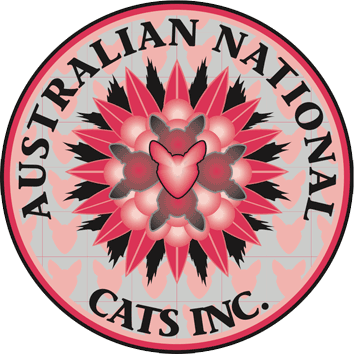
Australian National Cats Inc.



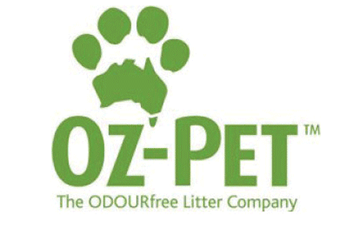

Our
Partners
ABN 40 794 819 336 ARBN 638 901 630
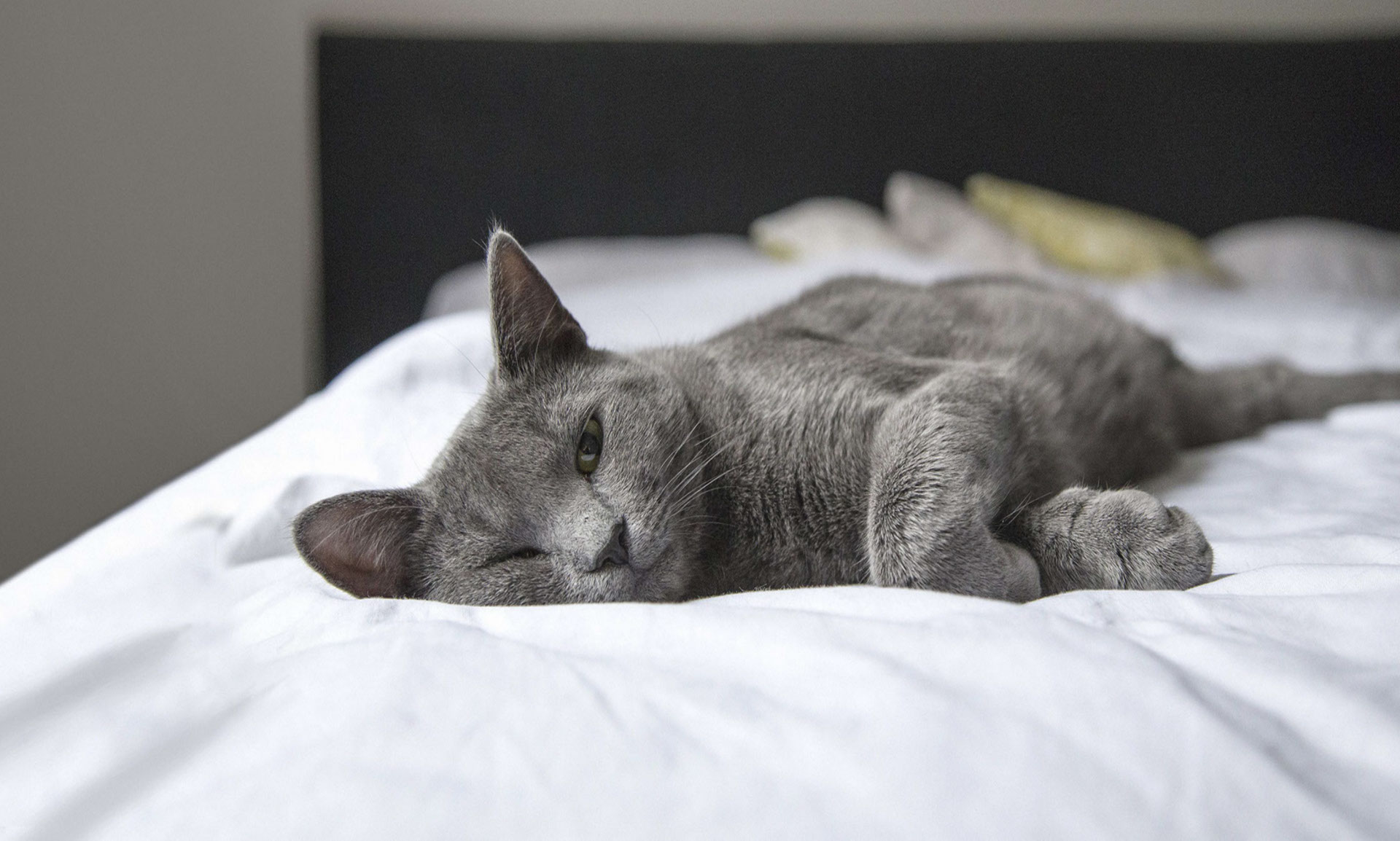
MISSION STATEMENT
To be a totally professional organisation responsive to the needs of all cats -their owners, breeders and exhibitors; and it’s strength as a totally new organisation, is able to utilise the latest technology and world-wide accepted procedures to improve the quality and companionability of all cats, making cat breeding, exhibiting and owning an enjoyable, rewarding event.
The Australian National Cats Inc (ANCATS) is a unique organisation responsive to the needs of all cats, their owners, breeder and exhibitors. Come visit anytime as a member or guest to find information on how to care for your cat, upcoming cat shows, join us, and visit our breeders, national partners and supporters.
Mostly though we want you to be part of ANCATS
ANCATS is the first and only national cat registery, and is affiliated with the World Cat Federation. ANCATS maintaining National Breed Standards, prefix register online, judges training program and breed committee We are particularly proud of our national junior handlers program. ANCATS presents both national and regional Cat of the Year (COTY) awards.
National phone number: 1300 738 228. All Registrations, show processing, status updates, and memberships utilize the " Cat Data " program featuring worlds best practices.
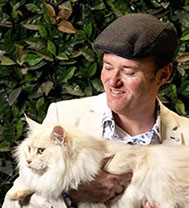 President
President
Aaron Heiler
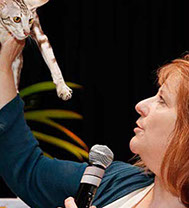 Secretary
Secretary
Jan van Dyk
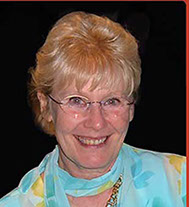 Vice President
Vice President
Bambi Edwards

Public Officer
Aaron Heiler
For More
information
please click here
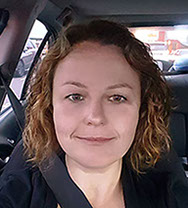 Committee
Committee
Nicole Whatson
 Executive
Executive
Consultant
Bambi Edwards
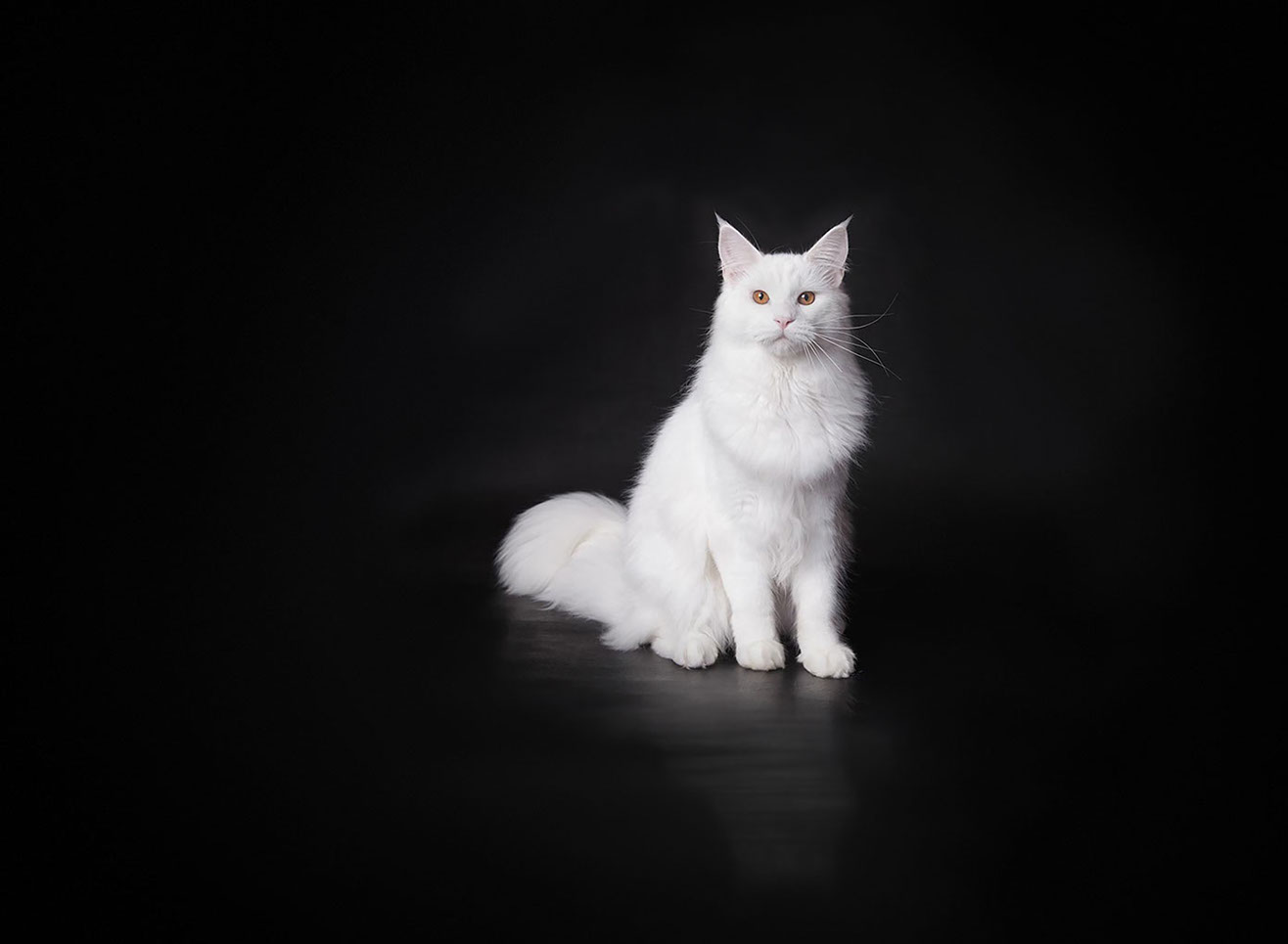
ANCATS Membership is for the love of cats and people too.
You can be a member just to be informed or you can enter your PEDIGREE OR DOMESTIC cat in ANCATS shows. Let your passion and pride lead you to a successful experience with winning entries taking home a first, second, or third place ribbon. We have a lot of fun sharing our thoughts, views and feelings about our wonderful hobby. Companionship, mateship, friendship…. Call it what you like, great relationships develop in an environment where ‘respect for others’ is seen as a foundation stone of a groups development. A philosophy Australian National Cats passionately subscribes too.
membership
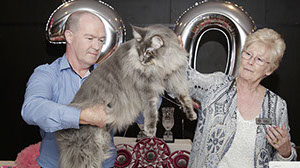
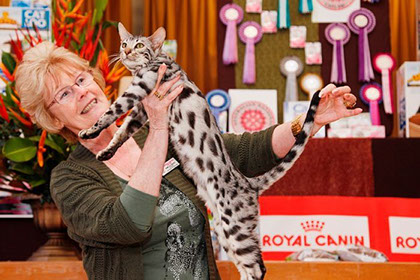

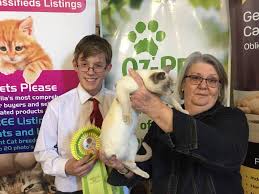
Membership
Application
Registration
Rules
Membership
Benefits
Fees
Register
Kittens
Join Breed
Council
Constitution
Breeders
Code of
Ethics
Code of
Ethics
Breeders
Guide
ANCATS
Standards
Breeders
Prefix
Application
Aussie
Prefixes
Membership
Prefixes
Apply for
Breeders
Listing
shows
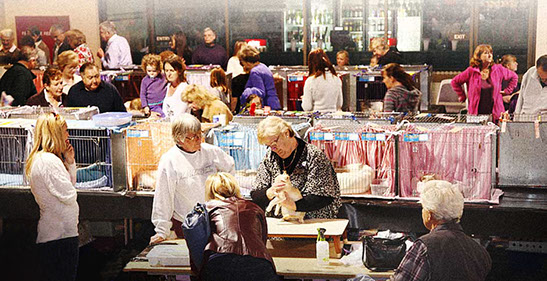

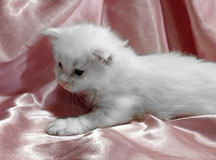
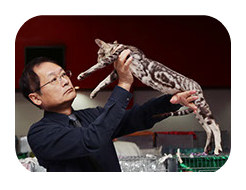
ANCATS Shows are great to watch or even be part of
" its fun, social and rewarding all at the same time."
You can be a member just to be informed or you can enter your PEDIGREE OR DOMESTIC cat in ANCATS shows. Let your passion and pride lead you to a successful experience with us.
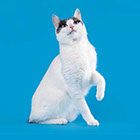
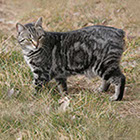
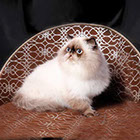
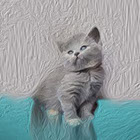
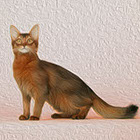
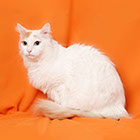
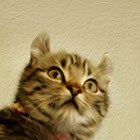
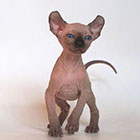
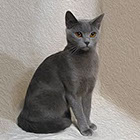
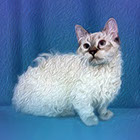
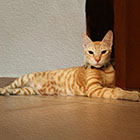
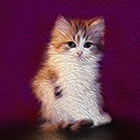
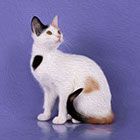
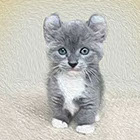
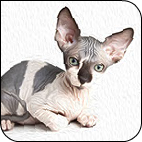
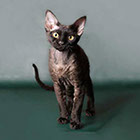
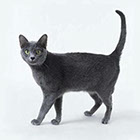
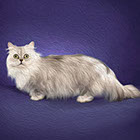
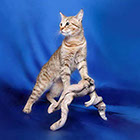
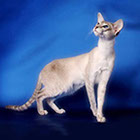
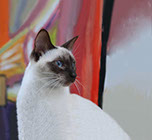
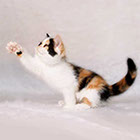
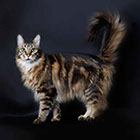
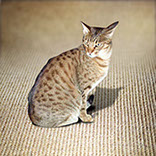
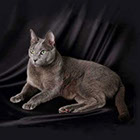
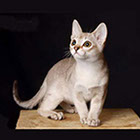
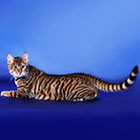
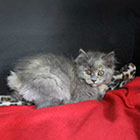
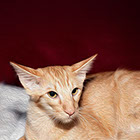
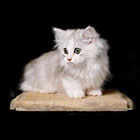
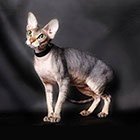
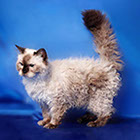
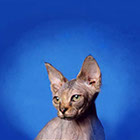
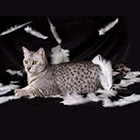

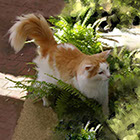
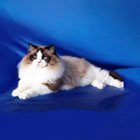
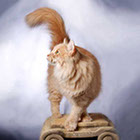
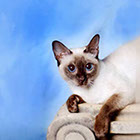
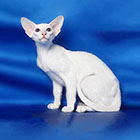
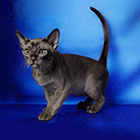
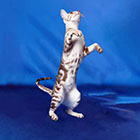
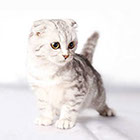
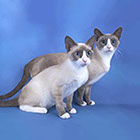
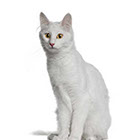
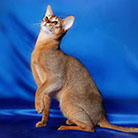
Abyssinian
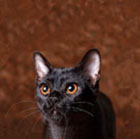
Bombay
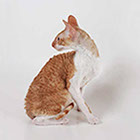
Cornish Rex
Japanese
Bobtail
Manx
Persian
Longhair
Scottish
Shorthair
Somali
Longhair
Turkish
Van
American
Curl
Elf
Chartreux
Skookum
Arabian
Mau
Ragamuffin
Aphrodite's
Giant
Kinkalow
Bambino
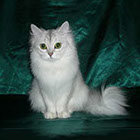
Australian
Tiffanie
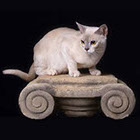
Burmese
Devon Rex
Korat
Napoleon
Pixie Bob
Siamese
Thai
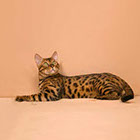
Bengal
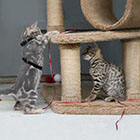
Cheetoh
Exotic
Maine Coon
Ocicat
Russian
Singapura
Toyger
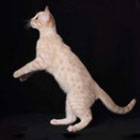
Australian Mist
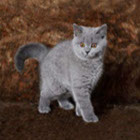
British
Shorthair
Cymric
Javanese
Munchkin
Peterbald
Selkirk Rex
Sphynx
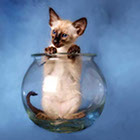
Balinese
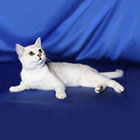
Burmilla
Egyptian
Mau
La Perm
Norwegien Forest
Ragdoll
Siberian
Tonkinese
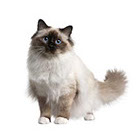
Birman
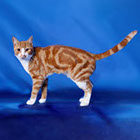
Companion Cat
Foreign
White
Mandalay
Oriental
Shorthair
Scottish Fold
Snowshoe
Turkish
Angora
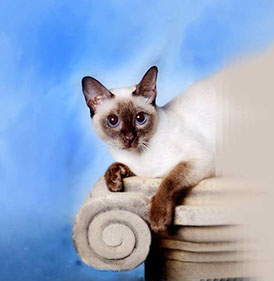 Tonkinese
Tonkinese
The Tonkinese is a modern revival of an ancient cat, derived from Siamese to Burmese breeding, relaxed, friendly and outgoing temperament. The ideal Tonkinese is not extreme in any aspect of its appearance and should be a beautifully balanced cat of intermediate type. It is elegant with a lithe and firmly muscled torso that is neither cobby nor svelte. It is medium in size; balance and proportion are of greater importance than type. Reach their peak around 2 years of age.
image by animaleyes.com.au
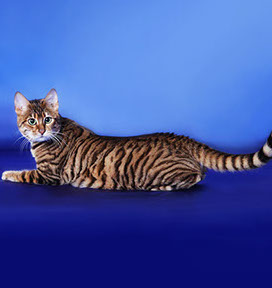 Toyger
Toyger
This breed is loving, glittered, medium-sized shorthair companion cat reminiscent of the big cats in pattern, type confidence and movement that came out of the Bengal breeding program. Toyger’s are uniquely beautiful cat willing and able to thrive in human-centered life. Companionability traits such as dependable, quiet temperament, laid-back personality, intelligent and easily trained and handled are all important and desirable and an integral part of the breed profile and standard.
image by animaleyes.com.au
Turkish Angora
The Turkish Angora is an ancient naturally occurring cat thought to originate from the mountainous regions of Turkey. The Turkish Angora was widely used in Persian breeding programs and was nearly lost as a pure breed until controlled breeding programs were introduced into Turkey. The Turkish Angora is a well balanced, graceful cat with a fine, silky coat that shimmers with movement. They have a long muscular body with fine bones. They are active, intelligent and outgoing cats.
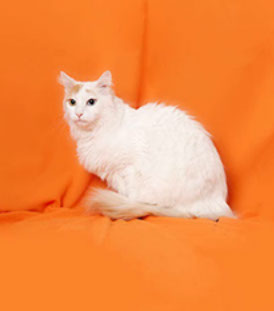 Turkish Van
Turkish Van
The Turkish Van is a naturally occurring semi-longhaired breed from the rugged region of Turkey, centered on Lake Van where the climate varies in extremes. Known for its unique, distinct pattern, they are treasured in their homeland and not readily available for export. The Turkish Van is a solidly built semi –longhaired cat with a great breadth of chest, substantial body and legs demonstrating its strength and power. The breed takes three to five years to reach maturity; therefore allowances must be made for age and gender. Individual cats should convey an overall impression of balance and proportion and a strong appearance in which no one feature is exaggerated. They are an intelligent and alert cat; some may handle better with all four feet on a solid surface.
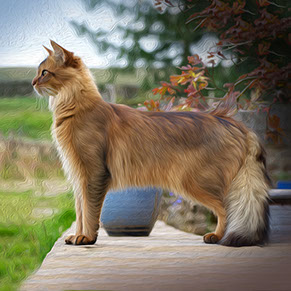 Somali
Somali
Somali (Abyssinian Longhair)
The name is fanciful as the breed was developed in the USA by the retention of long haired kittens produced by the Abyssinian. The Somali is a well-balanced cat of foreign type and medium build, regal in appearance, lithe, hard, and muscular with a well-ticked semi-longhair coat. Should appear eager and active, shows a lively interest in its surroundings.
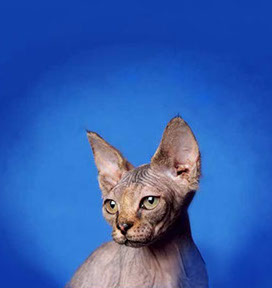 Sphynx
Sphynx
Sphynx is a popular breed in Europe, and particularly in France and the Netherlands. It is said that the hairless cat originated in Mexico in the pre-Colombian era. The Sphynx appears to be a naked cat, but in reality it is not truly hairless. Sphynx are sweet-tempered, lively and intelligent and above all amenable to handling.
Thai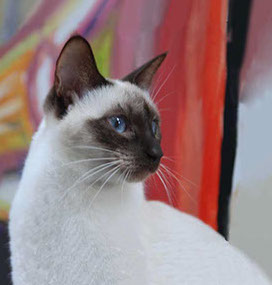
The Thai is intended to be both the living equivalent of the original “Wichien-maat” of ancient Siam and the “marten-faced” Siamese of early 20th century America and Europe the Thai is a medium-large pointed cat of foreign type reflecting its Thai origins. Thais are well balanced cats with no extremes and a unique
head shape
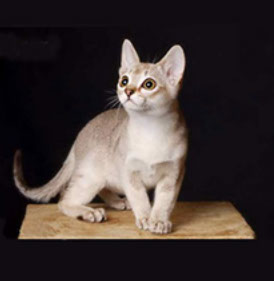 Singapura
Singapura
Singapura is the Malaysian name for Singapore Island and also designates a true common cat that walks the streets of the capital. In 1975 the breed was imported to California and developed from there. The Singapura is an alert medium to small-sized ticked tabby cat of foreign type with a striking face with noticeably large eyes and ears. The coat gives an impression of a refined and delicate colouring.
 Skookum
Skookum
These cats were created by crossings between LaPerms and Munchkins. They have been called "the Shirley Temple of the cat world". They are essentially Rex coated
Munchkins as opposed to short-legged LaPerms as after the first generation breeders do not generally breed back to LaPerms. They are playful, people loving and kittenish, even as adults.
Snowshoe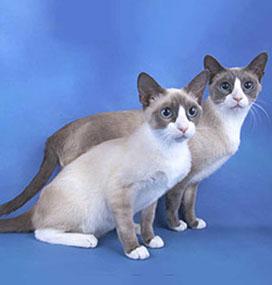
The Snowshoe is as individual as snowflakes, no two ever identical, the snowshoe breed is one of the rare cat breeds in the world. The breed originated in the late 1960s when Dorothy Hinds Daugherty of Kensing cattery (USA) had a chance litter between a siamese and an American shorthair that produced three pointed kittens with mittens and boots. Intrigued, she commenced work turning these charming cats into a breed. Her work was taken up by breeders in the 1970s and today there is an upsurge of interest in these magical cats as cat lovers discover their charm, human orientation, family friendliness, and high intelligence combined with unique beauty.
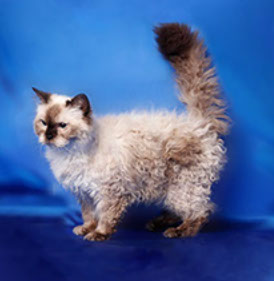 Selkirk Rex
Selkirk Rex
A fairly new breed, developed in 1987 in Wyoming USA. The Selkirk Rex is likened to a poodle or sheep and is known as being debonair though playful. The Selkirk Rex is different to the other Rexes in that its “rexing” is the result of a dominant gene affecting the guard, down and awn hairs and shows loose individual curls. As the original Selkirk Rex carried the longhair gene, the Selkirk Longhair is part of the breed group. As it takes up to 2 years for the coat to develop, kittens are mainly judged on head and body type.
image by animaleyes.com.au
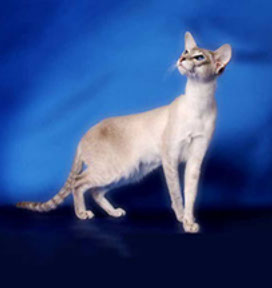 Siamese
Siamese
Siamese including Seychellois
Siamese were thought to have originated in Thailand in the 13th century. In Siam ownership of this beautiful cat was restricted to members of the Royal family. The ideal cat is a beautifully balanced svelte and elegant animal with long tapering lines, supple and well muscled. These slender cats have a surprising weight, with eyes a brilliant blue with an alert and inquisitive expression.
image by animaleyes.com.au
Siberian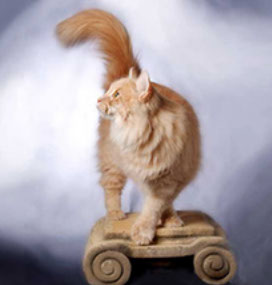
Siberian including Neva Masquerade
The Siberian is said to be Russia’s native forest cat with records dating back to the year 1000 but it was not until the 1980s that the Russian Cat Fancy decided to define the modern Siberian Cat. This is a cat that was born to survive the harsh Russian winters and has no extremes in type The Siberian is a medium to medium-large cat demonstrating overall strength, presence and alertness with a sweet facial expression. They are slow to mature taking as long as 5 years. Females are smaller than males and this should be considered when comparing the standard for young cats and females. Size is secondary to type. They give a general impression of roundness and circles rather than rectangles or triangles.
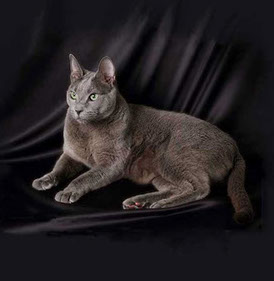 Russian
Russian
The Russian may have derived its name from Russian merchants who travelled the seas trading with England in the late 19th century. This popular cat was shown extensively at the Crystal Palace Shows in the 1850s. Originally the Russian cats were blue cats. Now there are Russian Blue, Russian White or Russian Black cats. They are all elegant cats of foreign type with a distinctive double coat, only seen in this breed.
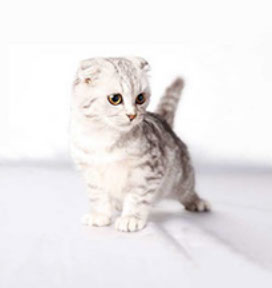 Scottish Fold
Scottish Fold
The Scottish Fold occurred as a spontaneous mutation in farm cats in Scotland and has been established by crosses to British Shorthair and Domestic cats in Scotland and England; in America to American and British Shorthair. Special attention should be given to the flexibility of legs and tail. Longhairs were developed in the USA A gently, fun-loving cat with ears set in a cap-like fashion. Always inquisitive and loves human company.
Scottish Shorthair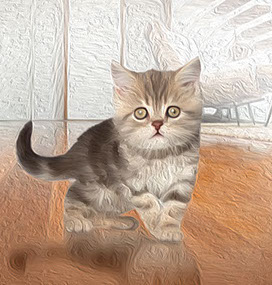
Developed during the breeding of Scottish Fold and British Shorthair, this breed has pert ears.
Pixibob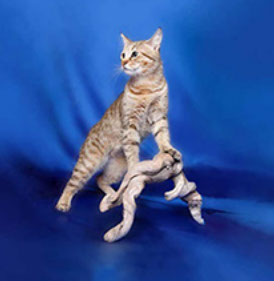
The Pixiebob is a relatively recent domestic breed that originated in the Northwestern United States. This is a medium to large-sized, muscular, brawny cat that was intentionally bred to closely resemble the wild Coastal Red Bobcat found in the mountains of the Pacific Northwest. Pixiebobs come in both long-haired and short-haired varieties, the short-haired Pixiebobs have a wooly thick double coat, giving them a pleasant padded feel when they are petted. The long-haired Pixiebobs have a long, silky coat with beautiful dark lines and spots throughout. The preferred Pixiebob is a spotted brown tabby ranging in shades from creamy to rich tawny to a deeper, more reddish brown. One of the more unusual characteristics of the Pixiebob is that polydactylism is common within the breed. Polydactylism means having up to seven toes extra toes.
image by animaleyes.com.au
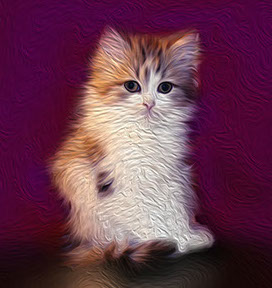 Ragamuffin
Ragamuffin
A group of breeders broke away from Ann Baker in 1993 so could no longer use the ‘Ragdoll’ name; they had been breeding all colours and patterns and chose the name RagaMuffin because they were descended from the urchin cats of Riverside.
Ragdoll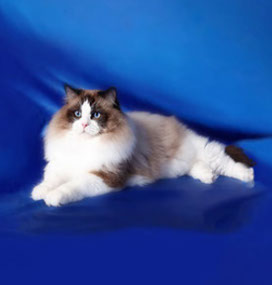
The breed was created in 1960s The overall impression of a cat relaxed in temperament, easy to handle, large, powerful, imposing, distinctively marked and of striking appearance. The ideal Ragdoll is a well-balanced cat with no extreme features. Ragdolls are slow maturing, reaching full coat and colour in approximately 3 years
 Oriental Shorthair
Oriental Shorthair
The Oriental Shorthair originated in England from a cross between a Siamese and an unregistered black longhair. The ideal cat is a beautifully balanced svelte and elegant animal with long tapering lines, supple and well-muscled. These slender cats have a surprising weight, with eyes brilliant green with an alert and inquisitive expression..
Image by animaleyes.com.au
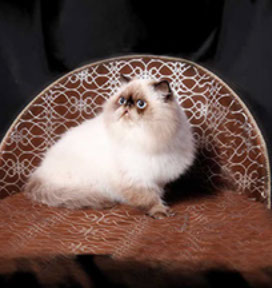 Persian Longhair
Persian Longhair
The world’s most famous breed originating in Persia and imported to Italy in the 17th century. Balance and refinement are the essence of the breed where all parts come together in a harmonious whole the ideal Persian should present an impression of a heavily boned, well-balanced cat, with a sweet expression and soft round lines.
image by animaleyes.com.au
Peterbald
The Peterbald cat was developed in 1994 in Russia from a mating between a Donskoy cat to an Oriental Shorthair It was found to have a hair losing gene. The Peterbald is an elegant medium size cat. The important aspect of this cat is the coat, which may vary from being bald, to velour, to brush.
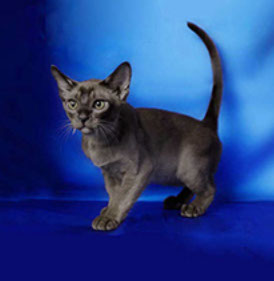 Mandalay
Mandalay
The Mandalay is a full colour expression Burmese cat and as such, type must conform in every way to the Burmese Standard, the only differences occurring in coat and eye colour. The relationship to Burmese is the same as Oriental and Siamese are to one another. The GCCF in England classifies the full expression Burmese as the Asian group. The Mandalay is an independent, gentle, fun loving and highly intelligent cat whose strength and endurance is a positive influence of the breed.
image by animaleyes.com
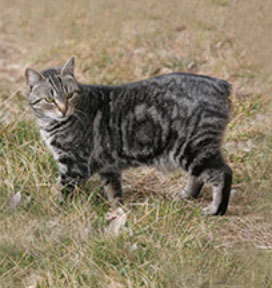 Manx
Manx
Is it the Leprechaun’s myth, or did the cat’s name derive from its native Isle of Man. We may never know, but the Manx was very popular in England in the late 19th century and is rare breed today. The breed is the result of a spontaneous genetic mutation caused by a dominant autosomal gene
Munchkin Shorthair or Longhair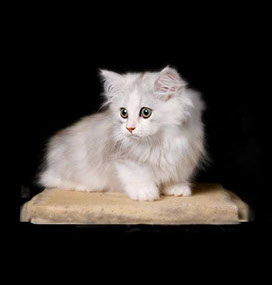
In 1983 Sandra Hochenedel of Louisiana discovered a short-leg cat she called Blackberry. The short legs are caused by a naturally occurring genetic mutation which results in hypochondroplasty affecting the long bones only with the rest of the cat normal size. They are outgoing, friendly and intelligent, as agile as other breeds of cat and they respond well to being handled. The Munchkin is a small to small-medium, semi-foreign in type, with distinctive short legs. They are as varied in colour and pattern as the domestic and apart from the short legs exhibit no extremes as the breed has been established with augmentation by out crossing to domestic and appropriate pedigree cats. They exhibit shortening and may have slight bowing of the long bones; this does not hamper mobility. The spine is unaffected and similar in form and flexibility to other cat breeds. image by animaleyes.com
Napoleon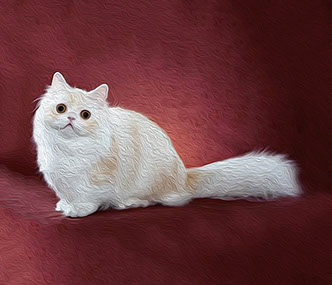
A short legged, stocky cat with heavy boning, round head, and round eyes with a colourful coat. They can be long or shorthaired. They are fun, playful cats who are as agile as long legged cats and very intelligent. Litters can have both short-legged (standard) and long-legged (Non standard).
image by animaleyes.com.au
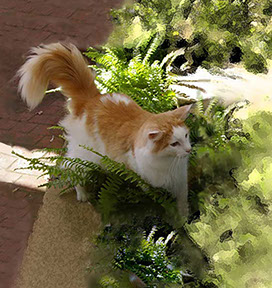 Norwegian Forest Cat
Norwegian Forest Cat
The breed originated as a natural outdoor hunter in the Norwegian forests who survived the harsh conditions. The appearance of this cat should reflect his natural heritage, and is a substantial but elegant semi-longhaired cat with an alert expression. The most important features are type and coat quality. Maturing slowly, full development of the cat can take up to four years to 6 years and kittens can take up to 6 months to develop guard hairs.
Ocicat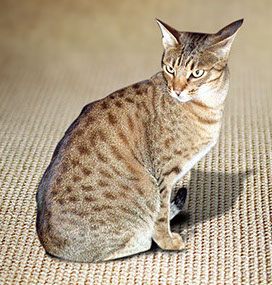
The Ocicat is a medium-large well-spotted agouti cat of moderate type. Although well-muscled and solid it is also graceful and lithe. Ocicat is a combination of the words “ocelot” (a spotted wild cat of the Americas) and “cat”.
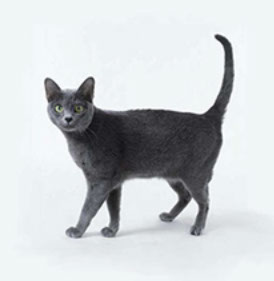 Korat
Korat
A rare cat even in Thailand, the country of origin, and because of its unusual fine disposition is greatly loved by the Thai people who regard it as a good luck cat.
La Perm Shorthair and Longhair 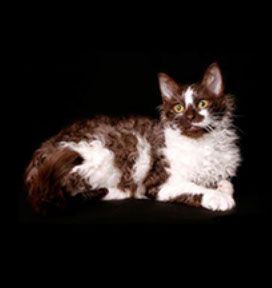
The La Perm originated in Oregon in 1982 when a kitten born bald subsequently developed a unique curly coat. It is a naturally occurring autosomal dominant mutation. Because of its curly coat, high neck and smallish head it has been called the Alpaca Cat. The La Perm is a medium sized curly coated cat with a semi-foreign body. The La Perm Shorthair differs only in hair length. Coat texture is distinctly different from other rex mutations and will vary within the breed. All parts of the body are in harmonic proportions. There is surprising weight for size. La Perms are alert, walk tall and are renowned for their friendly personality.
Maine Coon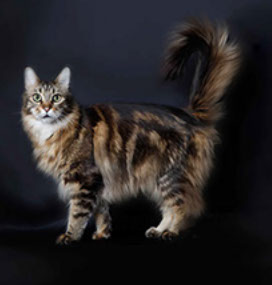
The Maine Coon is a semi-longhaired cat that has evolved its unique appearance through its adaptation to the harsh winters and varied seasons of North America’s New England region. A working cat with a powerful rugged appearance Maine Coons are a large breed with substantial boning, and a long rectangular and muscular body. An overall appearance of balance with no exaggeration is desired. This breed has a characteristic smooth but shaggy coat that has been adapted to varied environments. The Maine Coon should display a pleasant disposition. Quality should never be sacrificed for size. The Maine Coon takes up to four to five years to fully mature and allowances should be made for younger cats and adult females may be considerably smaller than males.
image by animaleyes.com
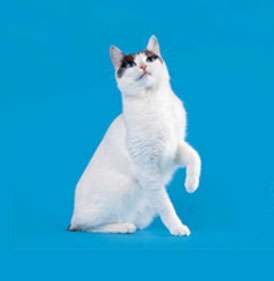 Japanese Bobtail
Japanese Bobtail
Known in the East since the 11th century, the Japanese Bobtail is a highly honored, venerated cat and symbol of luck and happiness in Japan. These cats are depicted with their front paw raised and have been portrayed by artists many times over the centuries. The Japanese bobtail should present the overall impression of a medium-sized cat with long clean lines and bone structure, well-muscled, but straight and slender rather than massive in build. Its short tail should resemble a bunny tail with the hair fanning out to create a pom-pom appearance, which effectively disguises the underlying bone structure of the tail. The cat can be shorthair or longhair.
Javanese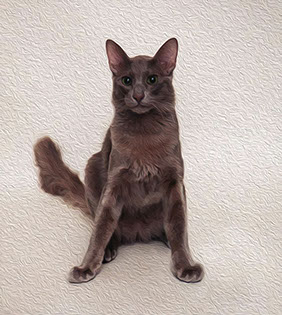
The ideal cat is a semi-longhair, beautifully balanced svelte and elegant animal with long tapering lines, supple and well muscled. These slender cats have a surprising weight. Eyes brilliant green with an alert and inquisitive expression. Was obtained recently by crossing Oriental Shorthairs and Balinese.
Kinkalow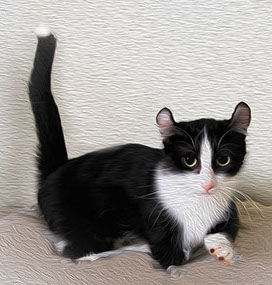
The Kinkalow is a hybrid breed created by crossing the American Curl with the Munchkin. The breed founder was Terri Harris, who introduced them to TICA in 1997 where they were granted Experimental status. A group of breeders in Australia and New Zealand have embarked upon a breeding program to re-create this charming little cat breed to Australasia. The Kinkalow inherits the kitten like nature well into adulthood from the American Curl and their confident outgoing loving nature of the Munchkin.
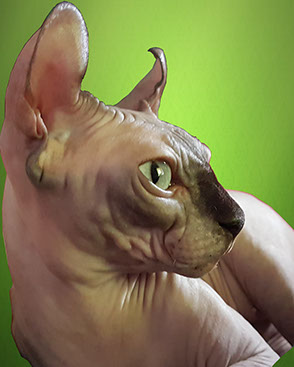 Elf
Elf
The Elf is a hybrid breed developed by crossing the American Curl with the Sphynx. The resulting progeny are then taken back to the Sphynx to attain the baldness required of the breed. The distinctive feature of the Elf is their unique, attractive curled ears and nakedness. The Elf appears to be a hairless cat, although it is not truly hairless. The skin should have the texture of chamois. It may be covered with very fine down which is almost imperceptible to both the eye and the touch. On the ears, muzzle, tail, feet and scrotum, short, soft, fine hair is allowed. Lack of coat makes the cat quite warm to the touch. Whiskers may be present; either whole or broken, or may be totally absent. The cat should not be small or dainty. Males may be up to 25 percent larger so long as proper proportions are maintained. The Elf is sweet-tempered, lively, intelligent and above all amenable to handling.
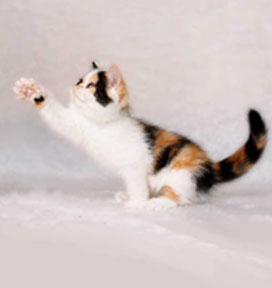 Exotic (Persian) Shorthair
Exotic (Persian) Shorthair
An American variety produced in the 1950s by careful selective breeding using outstanding American Shorthairs and the best Persian cats. The Exotic is a solid balanced cat with a massive head in proportion to its body, which should be short and cobby with broad chest, short sturdy legs, large paws and a short full tail.
image by animaleyes.com.au
Foreign White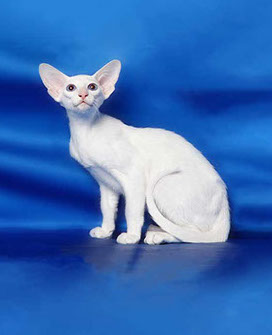
Originated in the United Kingdom in the early 60s when a white cat accidentally mated with a Siamese producing the beautiful, elegant Foreign White we know today. The ideal cat is a beautifully balanced svelte and elegant animal with long tapering lines, supple and well muscled. These slender cats have a surprising weight, eyes brilliant blue with an alert and inquisitive expression.
image by animaleyes.com
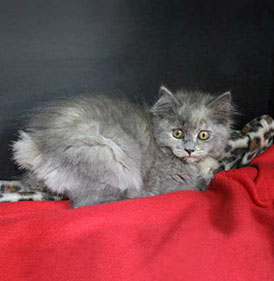 Cymric
Cymric
The Cymric was selectively bred in North America. It has been reported that the first Cymric appeared in litters of pedigreed Manx in Canada in the 1960s. This tailless cat originating on the Isle of Man, the Cymric is a semi-Longhair cat with a cobby body.
Devon Rex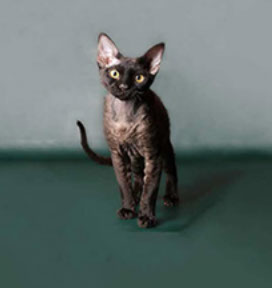
The Devon Rex originated in Devon, England in 1960 and was called Kirlee. A medium sized curly-coated cat with a lovely mischievous expression of his head and an elfin (pixie) look. The Devon is alert and active and shows a lively interest in its surroundings.
image by animaleyes.com
Egyptian Mau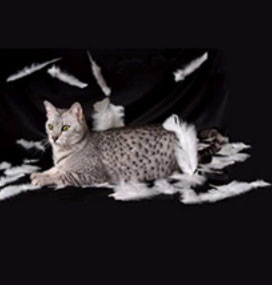
Princess Troubetskoy introduced the first Mau, a natural breed, into the United States in 1957 from Egypt. They are said to have typical Egyptian type.
image by animaleyes.com
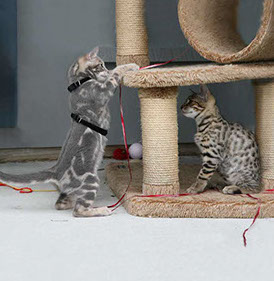 Cheetoh
Cheetoh
The Cheetoh is the newest blend of pedigree cat, utilizing very specific bloodlines of the Bengal and the Ocicat, by Carol Drymon of Wind Haven Exotics, U.S. the first litters arrived in 2003. The cheetoh has a super affectionate nature and real love for their human companions, they areintelligent with the ability to learn quickly. Their amazing coat pattern consists of lots of spots and a few stripes for good measure, replicating the look of their wild counterparts The head is slightly chiseled and the ears are more prominent than the Bengal. They walk with a lower front stance and higher at the back, a generous sized cat with males being more musclular with thick necks and solid bodies, 7kg fully grown. The female has a slightly smaller frame but is still a good size when compared to the average moggy.
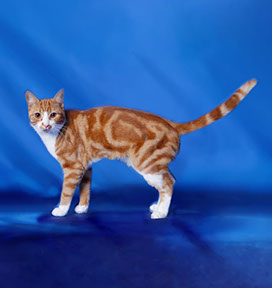 Companion Cat
Companion Cat
The companion cat is an altered feline of unknown ancestry or of known or obvious pedigree, which is not eligible to be shown in pedigree classes. They are judged in the following groups: Domestic – any cat not looking like a purebred (your basic alley or moggy cat). Part pedigree – a pedigree cat that cannot be shown in the pedigree class because does not comply with the standard e.g. mismarked, wrong pattern.
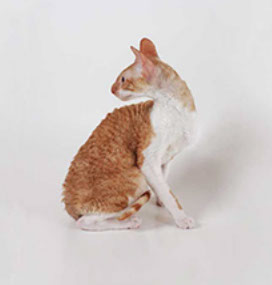 Cornish Rex
Cornish Rex
The first Cornish Rex originated in Cornwall, England in 1950 on a farm and was called Kallibunker and the breed developed from there. The Cornish Rex is an elegant fine-boned medium sized cat with a curly coat without guard hairs. By nature the Cornish Rex is intelligent, alert and generally likes to be handled.
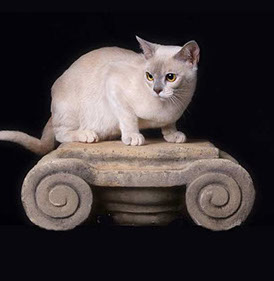 Burmese
Burmese
The origins of the Burmese may be questionable, but legend has it that Manuscripts from Ayutthaya, former capital of Siam, dating to the sixteen and seventeenth century depict cats that resemble today’s Burmese (extract from The Cat Encyclopedia). Burmese were first recognised in 1936 as a breed and today is a household name. The Burmese is an independent, gentle, fun loving and highly intelligent cat whose strength and endurance is a positive influence of the breed.
Burmilla 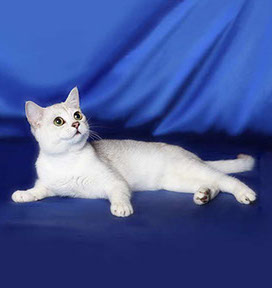
The Burmilla cat originated in the United Kingdom as a result of an accidental mating between a Chinchilla Persian and a Lilac Burmese. The Burmilla is an elegant Agouti silver cat of foreign type, in the shaded and tipped coat patterns.
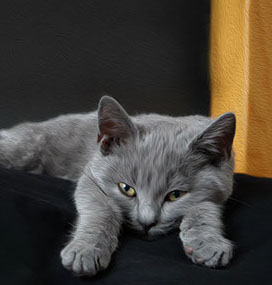 Chartreaux
Chartreaux
This breed is very old. Its short woolly coat is said to have been sold as otter fur in ancient times. Bred by the Carthusian Monks in the monastery, the La Grand Chartreux.
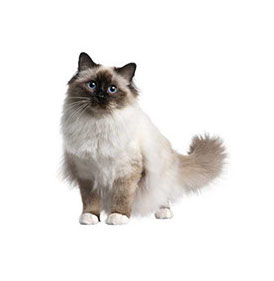 Birman
Birman
A deep mystical tale is written about the original Birman and his master. The white paws are a symbol of purity. A gentle and affectionate cat, but also quiet and peaceful with a soft voice, this cat is a favorite and is very impressive with their brilliant blue eyes and white gloves.
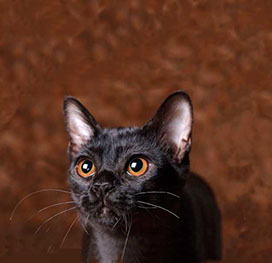 Bombay
Bombay
This breed was originally a hybrid between Burmese and American Shorthair with an unmistakable look of its own, known as the miniature “black panther” of the cat world. In Australia the introduction of Black British was used in the breeding program in place of the American Shorthair. Friendly, alert, and an outgoing cat, muscular and with a surprising weight for its size.
British Shorthair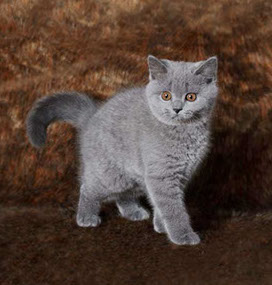
The British Shorthair is the native cat of Britain that was seen in every street, taken from rags to riches through its development from the 19th century. British shorthairs are a compact, and well balanced, powerful cat, with an alert appearance and in perfect physical condition.
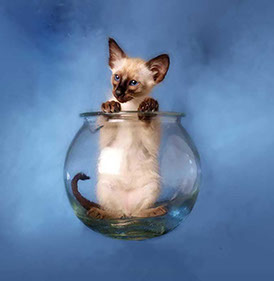 Balinese
Balinese
This breed is named after Balinese dancers because of their elegance and gracefulness. The ideal cat is a semi-longhair, beautifully balanced svelte and elegant animal with long tapering lines, supple and well muscled. These slender cats have a surprising weight eyes brilliant blue with an alert and inquisitive expression.
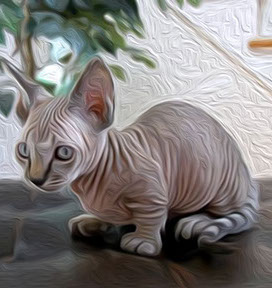 Bambino - Experimental
Bambino - Experimental
Bambinos are the deliberate hybrid from a sphynx and munchkin they are short legs and no coat although not truly hairless. The skin should have the texture of Chamois. They maybe covered with a fine down that is almost imperceptible to the eye and touch.
Bengal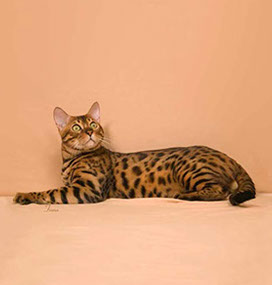
The goal of the Bengal breeding program is to create a domestic cat which has physical features distinctive to the small forest-dwelling wild cats, specifically the Asian Leopard Cat (Prionalurus Bengalensis) but with the loving, dependable temperament of the domestic cat. Keeping this goal in mind judges shall give special merit to those characteristics in the appearance of the Bengal, which are distinct from those found in other domestic breeds. The conformation gives the Bengal cat a basic feral appearance. Its luxurious coat has the distinct and special soft feel.
image by Fiona
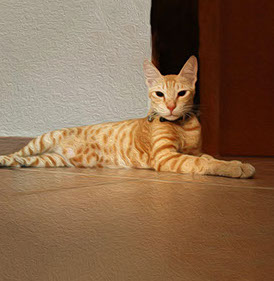 Arabian Mau
Arabian Mau
The Arabian Mau is the native domesticated cat of the Arabian Peninsula and Arabian Gulf region. It is believed to have been present in the area for 1,000 years.
Ms Petra- Khadija Mueller conducted a 5 year study of the breed in the UAE / Dubai and in 2008 the Arabian Mau received breed recognition by the World Cat Federation (WCF).
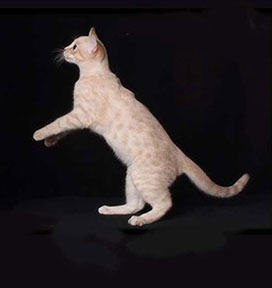 Australian Mist
Australian Mist
The Australian Mist was the first breed to be developed exclusively in Australia from Burmese, Abyssinian and Domestic Shorthair ancestry. First recognised for championship status 1986 and is now recognised by all WCF affiliates. The Australian Mist is a well-balanced cat of moderate type, with no tendency to extremes in any characteristic. Facial expression is open and generous. Should feel firm with rounded contours..
Australian Tiffanie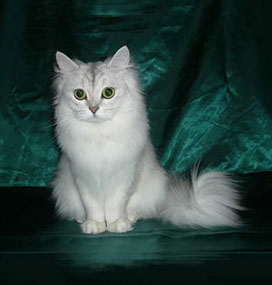
The Australian Tiffanie breed was developed in Australia in the late nineties from the Burmilla Breeding Program. Enthusiasts decided to develop this breed separately from the Burmilla longhair by breeding back to the Chinchilla Persian. The Australian Tiffanie is a semi-longhair cat with a silky tipped or shaded coat in silver or golden, and their temperament is sweet and gentle. A medium sized cat, substantial in body and bone.
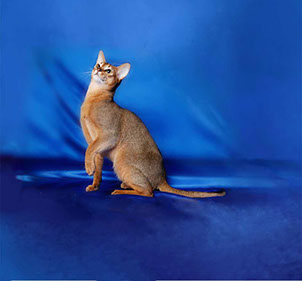 Abyssynian
Abyssynian
One of the oldest known breeds, the Abyssinian was thought to originate in Egypt. Geneticists now believe the true origins are in parts of S.E. Asia and along the coast of the Indian Ocean. The Abyssinian was named after the first cat that was exhibited in England which had come from Ethiopia (formerly Abyssinia) in the nineteenth century. The Abyssinian is a well-balanced cat of foreign type, and medium build, regal in appearance, lithe, hard, and muscular with a well-ticked short coat. Should appear eager and active, shows a lively interest in its surroundings.
 American Curl
American Curl
The American Curl is a medium-built, well-balanced cat, semi-foreign in type. The American Curl is the result of a spontaneous ear mutation in the domestic cat population of the United States. The first such cat was found in Southern California in 1981 and named "Shulamith". The distinctive feature of the American Curl breed is their unique, attractive curled ears. American Curls are a well-balanced, moderately muscled,
medium built cat. They are alert and active with gentle, even dispositions.
Aphrodite's Giant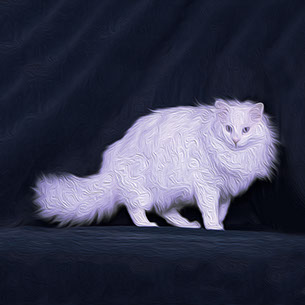
The Aphrodite's Giants are based on the oldest documented cat that lived tame with humans. Found in a Stone Age grave with a skeleton similar to the Aphrodite's Giants cats living today on the island of Cyprus. At the UC Davis laboratories in the USA; Dr Leslie Lyons worked on a Genetics research program that has produced a specific fingerprint for purebred cats. 30 Aphrodite's Giants were also investigated and shown genetically. From the basis of DNA scans, Dr. Lyons has agreed that the genetic fingerprint of the
Aphrodite's Giants is very consistent and could be recognized on this basis as a breed.
judges
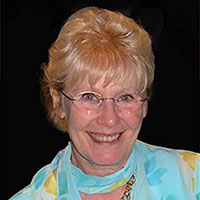
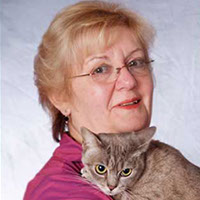
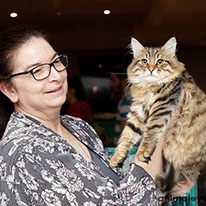
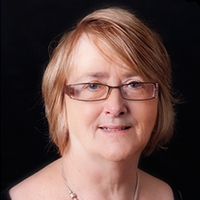
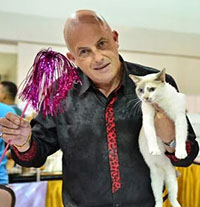
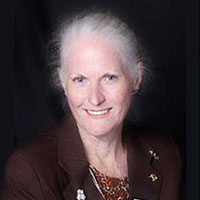
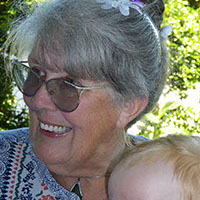
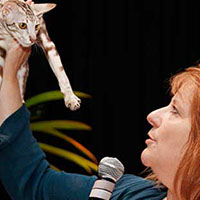
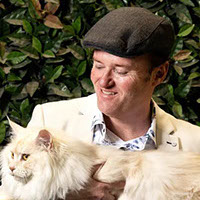
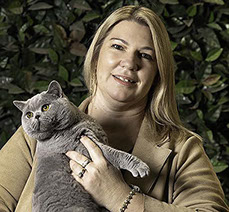
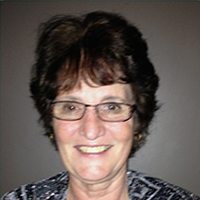
International All Breed Judges
Trainee Judges
Sue Martin
Wendy Black -WA
Shirley White
Matt Branagh
Wendy Slatter
Truda Straede
Jane Van Dyk
Aaron Heiler
Bell Parsons -Vic
Angela Irvine
Lead tutor and international All Breed Judge
Bambi Edwards
Application
to be a
Judge
Judges
Schedule of
Fees
Judges
Training
Scheme
Judges
Code of
Ethics
Judges
Protocol
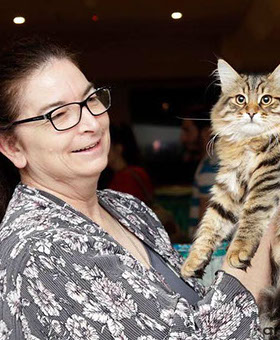 Wendy Black
Wendy Black
Living in Perth, Western Australia.
I grew up amongst pet farm cats and when I married Graeme in 1983, he got me my first pedigree kitten, a Birman Seal Point female as a wedding gift to me. This was the start of our breeding and showing life under the prefix of Satori. We bred Birmans (Seal and Blue Points) until the early 2000s when we gave up breeding due to our 2 human children taking up other interests. We did keep a couple of our cats until they decided to go over the rainbow bridge. In the early years of our breeding and showing, we became involved with the Birman Cat Club of Australia in NSW where I was put to work in the admin area for shows. Also during this period, we had lived in 4 different states as we were transferred around with work.
In 2010 we obtained a Russian Blue alter male who I ended up showing. This was when I became a steward with COAWA and became their show secretary for many shows. I also have done stewarding with CatsWA (was FCCWA).
After being with COAWA for a short time I transferred to ANCATS and steward at their shows. In 2016 I began my judges training in Longhair and Semi-Longhair.
In 2016 I obtained an Oriental Cinnamon Silver Classic Tabby alter male which I showed for a couple of years before he decided he no longer wanted to be shown at shows.
We currently have a Russian Blue, an Oriental, a Cocker Spaniel (dog) and numerous fish.
 Bell Parsons
Bell Parsons
As a mother of four wonderful children, my lifelong connection with animals has shaped my journey. With a background as a devoted vet nurse, I spent 18 years passionately breeding and exhibiting dogs. Sharing my knowledge, I taught dog grooming at TAFE, inspiring others to embrace the world of animal care.
In 2016, my heart was captured by British Shorthairs, prompting me to downsize my dog breeding and focus on these majestic cats. Importing several British Shorthairs enriched my cattery, and my love for feline companions grew.
As a DNA collector for Animal Network, now Orivet, I contributed to genetic advancements. Specializing in breeding AI with dogs was a thrilling challenge that pushed my expertise.
My thirst for knowledge led me to learn about cats and various breeds, making becoming a Judge a natural step. Excitedly to be apart of ANCATS, I celebrate the beauty of each feline contestant.
My life's journey has been a testament to the fulfillment that comes from following one's passion for animals. I aim to inspire others to cherish and protect these incredible beings, fostering a world of hope and compassion.
 Angela Irvine
Angela Irvine
I emigrated from the UK in 1968 with my family and was never allowed any animals. I soon rescued a kitten from the Cat Haven once I left home and my love of cats began. I started breeding Birmans in the late 80's but then discovered Ragdolls and became one of the early pioneers of the breed. I have helped take this magnificent breed from those early days to where it is today through breeding, seminars, mentoring etc.
It was on a trip to the US to buy a breeding pair of Ragdolls that I met Anne Baker, the Founder of the Ragdoll breed and also met my first Sphynx and my love took over for that breed as well. I pioneered the Sphynx breed in Australia and have taken it to where it is today together with the help of some very good breeders. I am a qualified steward and took on my judging as I wanted to give back to the Cat Fancy, especially ANCATS the knowledge and joy it has given me.
I am very proud to say that I am now an All breeds Judge.
 Wendy Slatter
Wendy Slatter
Hello everyone,
My name is Wendy Slatter and I am an absolute lover of all cats, but my dream was to breed and show the wonderful stunning Persian. I have been fortunate to have been able to follow this dream with success in acquiring beautiful breeding cats, gaining informed knowledge of breeding , cat issues and concerns and grooming . This together with the friendships and advice received from my cat people peers has enabled me to then go on to produce my own Karahaven Persians.I live in Townsville North Queensland together with my partner of 23 years and my beautiful furry kids. I also work full time. I have breeding and showing the beautiful cats over a period of 30 years. However there was period of not showing as I married and reared a family of 5 children. As all children left the family home my Pet babies came back into the forerun of my life.
I have had many Supreme Exhibits in many cat shows, often with the Karahven Persian winning these awards. Primarily my first love was with beautiful Persian Chinchillas and Cameos but my need to explore the breed lead me to the lovely cream and smoke varieties which are available.
Currently together with my Persians I have fallen love with the cute and delightful new breed known as the Munchkin and have been very fortunate to have been granted the honour of being supplied with both short hair and longhair Munchkins . My ultimate forward breeding plan is to produce Karahaven Napoleons. (I call them Persian Munchkins ). My love of the cats and showing has lead to me to the most important decision to date. That is to progress with my judging regime and I have had the pleasure of working and learning from many experienced and wonderful expert judges and tutors which will afford me the ability to gain more knowledge and love all the breeds as well as I do my Persians
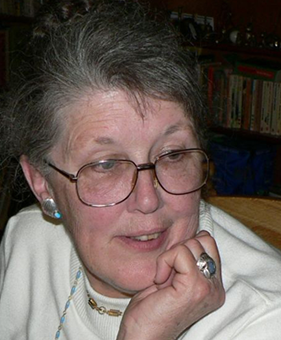 Truda Straedet
Truda Straedet
In 1977 I received approval from the RAS Cat Club of NSW (later NSWCFA)to develop Australia’s own breed of pedigree cat. (Spotted, later Australian Mist). Since that time I have pursued this dream to full realisation, with the 25th Anniversary of full register status being celebrated in 2011. Australian Mist are now recognised all round the world, with TICA the most recent to do so. I have been involved in Cat Politics, being on the Management Committee of the RASCC (later NSWCFA) for 9 years, and Editor of their Journal for 6. On relocating to Victoria in 2001 I joined FCCV, and was appointed to their Management Committee. In both States I represented my cat body on State advisory committees.
I trained as a Judge in NSW and Victoria, and have judged in NSW, Queensland, Victoria and SA.
I have written extensively on cat husbandry and breeding practice, culminating, with guidance from my vet and mentor Dr Karen Hedberg, in the publication of ‘Breeding Cats ….a practical guide’.
While I have been an active exhibitor and breeder of both Australian Mist and Maine Coon, I have in recent years downsized considerably, but continue to breed on a much smaller scale, to conform with new State regulations.
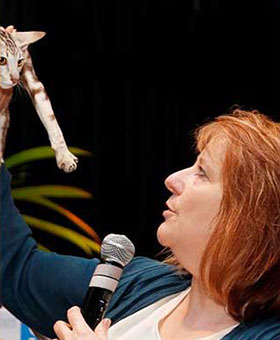 Jane Van Dyk
Jane Van Dyk
Hello everyone,
have been breeding Burmese and Mandalays since 1993, and judging since 2001.
I originally trained in All Shorthair with the NZCF, and finished All Breeds with ANCATS.
Cinnamon colour Burmese and Mandalays are my passion, and have been extensively involved in Rod Hitchmough’s cinnamon burmese programme, introducing this colour into Australia after relocating country.
Recently, I welcomed a beautiful Siamese girl from Hetty into our family and look forward to working with a new breed.
I have served on the NZCF Executive and Breed Standards Committee, and currently serving on the ANCATS Breed Standards Committee.
Melbourne is my home, with my two adult children and feline friends.
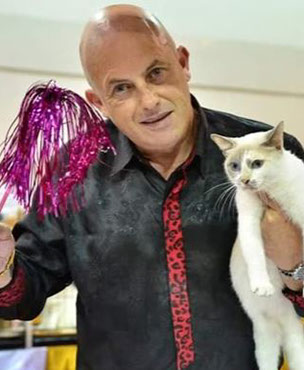 Matt Branagh
Matt Branagh
For over 35 years I have been breeding under the prefix Barradene. I have owned and bred Burmese, British Shorthair, Siamese, Oriental, Foreign White, Peterbald and Maine Coons.
Following strict breed standards I have exhibited with Supreme and Best in Show results.
I have judged since 2004, Group 2 and 4, and have through a continual process, extended my judging licence towards all breeds.
Some fond highlights
- Involvement of the Peterbald breed and standard to Australia – 2012.
- Judging in Kuala Lumpur, MALAYSIA, 2016 & Johor, MALAYSIA, 2017.
Outside the cat world, I run my own consultancy ‘Let’s Talk About Trees’ & am a Senior Lecturer AQF in Arboriculture.
At other times, I am involved in exhibition Canaries, and Aulonocara Cichlids.
 Ern Fuller
Ern Fuller
I was reared in a semi-rural situation in NZ with cats (British Shorthair), dogs (Fox Terriers), cows, sheep, thoroughbred horses and a variety of poultry. My early days of showing involved horses and when I arrived in Australia in the late 1950’s began to show Terriers. Always having a Brit and the occasional Moggie I started to show a Bombay in 2002. I then bought a Show British Shorthair in 2006 and have been breeding and exhibiting both Bombays and British Shorthair since. I began judging Group 2 Cats in 2007 and became an All Breeds Judge in 2010.
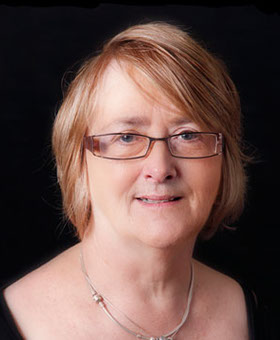 Shirley White
Shirley White
My first passion has been the Siamese, with Jeff purchasing my first pedigree Siamese in 1968. From there it was a short leap into the show scene, and we have been part of the show scene since then. We had lived in S Australia, Tasmania and currently reside in Canberra.
From the first Seal Point we soon branched into other breeds and had bred and owned many of the breeds, having bred pedigree cat in all of the breed groups. We began experimental breeding in 1971, owning experimental Orientals, a love that has never been far from our hearts. We bred Persians and were early breeders of the Exotic Shorthair, breeding them to full register. Of course we cannot forge our other love, the Burmese and Abyssinian cat, where we bred the first chocolate and lilac Burmese in Tasmania. We also cannot leave out our involvement with the Abyssinian, with our famous stud boy, Absin Howzat being a benchmark in Abyssininan cat in the 80’s.
This began my involvement with judging, and now hold all breeds status and with my overseas judging appointments, have gained international judge status. I am licenced as a World Cat Federation judge.
Of late we have combined our love of the Siamese/Oriental with our newest arrival, the Peterbald, with our importation bringing the first of this breed into Australia. We are enjoying the learning curve this breed has bought to our lives, and are breeding them in the bi colour pattern.
During the week, I work as a special education high school teacher in the Canberra region.
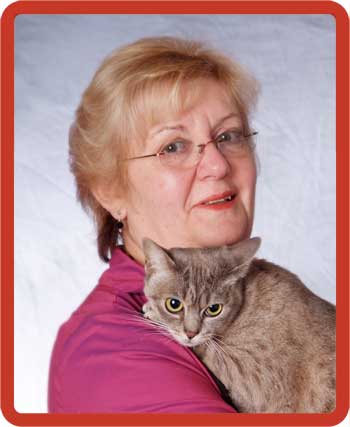 Sue Martin
Sue Martin
Sue Martin is a breeder of Australian Mist. She was one of the formulator of the new judges course which is based on the VET (Vocational Education Training) and AQF (Australian Qualification Framework).
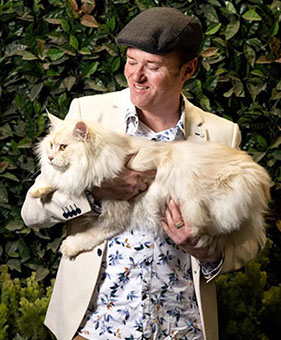 Aaron Heiler
Aaron Heiler
With a journey that began in 1995, my deep passion for breeding and showcasing cats has led me to numerous Best in Show and Supreme Exhibits, instilling immense pride and joy. Alongside my involvement as an ANCATS steward and attainment of the All Breeds Judge title, I have extended my commitment to animal welfare. As a director on the Animal Welfare League NSW board and a founding member of the Jervis Bay/Nowra branch, I actively promote and safeguard the well-being of animals. Together with Brian and Bambi, I co-founded ANCATS in Western Australia, focusing on preserving and enhancing the beauty of Burmese, Siamese, Orientals, and Foreign Whites. Upholding excellence and welfare remains my unwavering dedication to the feline community.
 David Crymble
David Crymble
My passion for cats has been ongoing for over thirty years. I attained my first prefix in 1981. I have loved many breeds and started out breeding Siamese then Burmese and Russians.
After a short time living overseas, I returned to New Zealand where I fell in love with the fabulous LaPerm and the Munchkin, recently introduced to New Zealand. I have been smitten ever since, adding the charming Napoleon to the mix in 2012. I am also proud to be the mentor and breeding partner of friends who breed Abyssinians and Selkirk Rex.
I became a Shorthair Judge in 2002, a Shorthair Tutor in 2009 and an All Breeds Judge in 2012.
I have been involved in Club and Association administration for many years, culminating in being elected as Chairman of Catz Inc. twice.
New Zealand is often called the seventh state of Australia as we share so much with our close neighbour. This close alliance is one of the reasons I am proud to become an Ancats judge, where there is better opportunity to see a larger variety of felines than I see in New Zealand.
Bambi Edwards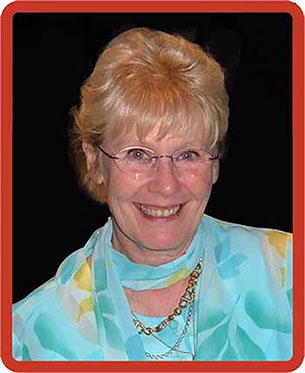
I have judged across Australia and the world. Apart from Australia the countries in which I have had the pleasure of judging include the UK, France, Belgium, Malaysia, USA, Japan Dubai and NZ. I am also a very active exhibitor and breeder at Bajimbi. I am involved in many TV shows with my cats. Along with Brian I was co founder of the Waratah State Cat Alliance in 1997, and proudly now ANCATS.
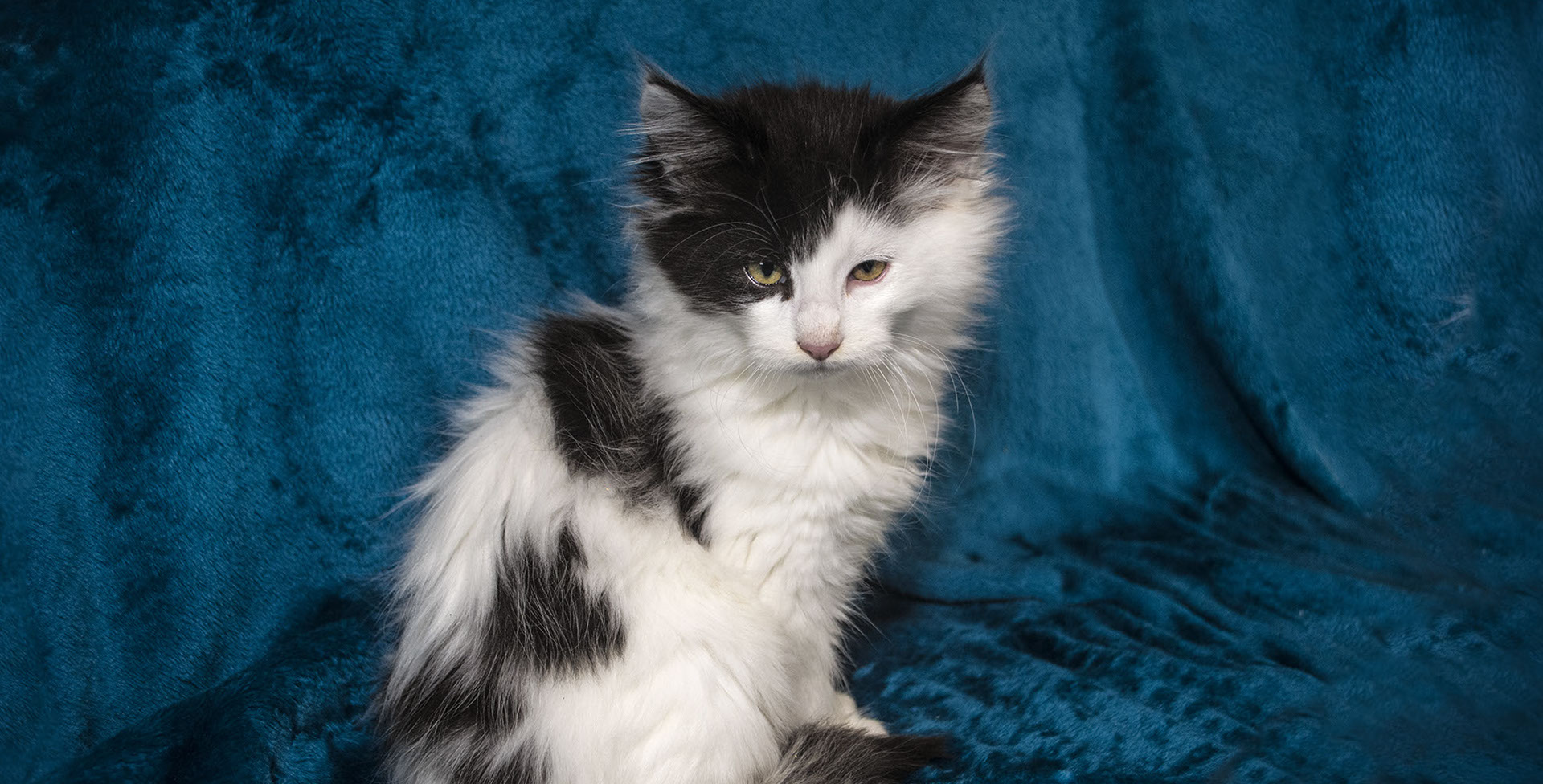
Cattery
of
Excellence
Challenge
Points
Recognition
Form
ANCATS
Breed
Council
ANCATS
Membership
Form
ANCATS
Enter Show
Online
ANCATS
Victorian
Code of
Practice
ANCATS
Title
Upgrades
ANCATS
Standards
ANCATS
Judging
Application
Breeders
Code of
Ethics
Forms

Address Details
Australian National Cats Inc
PO Box 2478
Taren Point Business Centre
Taren Point, NSW 2229 Australia
Bank Details
Australian National Cats Inc
BSB 032-052
Account No 11-8760
Swift code WPACAU2S [For international transfers]
Westpac Banking Corporation
94-96 Cronulla Street
Cronulla NSW 2230
Australia
P: 1300 738 228
contact us
